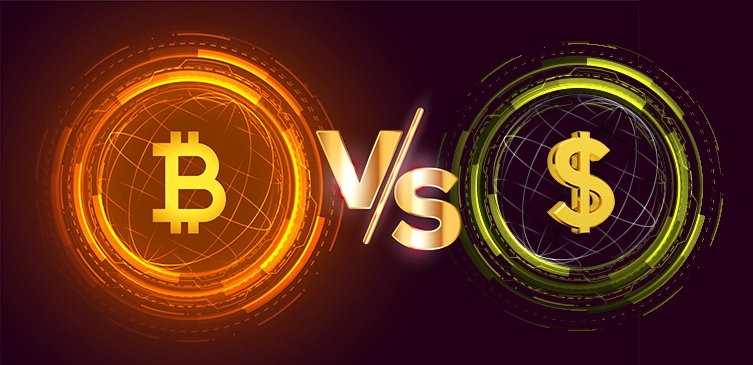Comparison of Cryptocurrencies with Fiat Currencies: Advantages and Disadvantages

Comparison of Cryptocurrencies with Fiat Currencies: Advantages and Disadvantages
Introduction
The comparison of cryptocurrencies with fiat currencies has created a major challenge for traditional money with the arrival of digital currencies to the financial world. Fiat currencies, such as the dollar, euro, and rial, have long been the backbone of the global economy. These currencies are controlled and managed by governments and central banks and are used in all of people’s daily transactions. However, with the emergence of digital currencies like Bitcoin and Ethereum, the definition and nature of money are evolving. Digital currencies, which operate on blockchain technology, enable individuals to execute secure and decentralized financial transactions without intermediaries such as banks.
 Comparison of Cryptocurrencies with Fiat Currencies
Comparison of Cryptocurrencies with Fiat Currencies
In this article, we will closely compare these two types of currencies—fiat and digital currencies. We will examine the advantages and disadvantages of each and analyze the differences between them in aspects such as control, management, inflation, and transactions.
Definition of Fiat and Digital Currencies
Fiat Currencies
Fiat currency refers to traditional money that is issued and controlled by governments and central banks. These currencies do not have a physical backing like gold or silver; their value is based largely on the trust people have in the government and the economy of a country. For example, the US dollar, the euro, and the Iranian rial are fiat currencies that are managed by their respective governments.
These currencies are used for daily transactions, international trade, and investments, forming the backbone of the global financial infrastructure. Central banks can control the money supply by printing new money or adjusting monetary policies.
Digital Currencies
Digital currencies, especially decentralized currencies like Bitcoin, Ethereum, and Ripple, are produced and managed electronically using blockchain technology. Digital currencies are not controlled by any government or bank and operate in a decentralized manner. They are used for transactions, investments, and even as a store of value, and are typically built on blockchain technology which provides high transparency and security for transactions.
One of the main features of digital currencies is decentralization; no single government or central authority can control them. In addition, many digital currencies have a fixed production limit, which effectively helps control inflation.
 Comparison of Cryptocurrencies with Fiat Currencies
Comparison of Cryptocurrencies with Fiat Currencies
Comparison of Fiat and Digital Currencies in Terms of Control and Management
One of the main differences between fiat and digital currencies is how they are controlled and managed.
Control and Management of Fiat Currencies
Fiat currencies are completely controlled by governments and central banks. Central banks are responsible for issuing and managing these currencies. They adjust the value of fiat currencies using monetary and fiscal policies. For example, a central bank can change interest rates, print new money, or regulate the circulating supply of money.
This centralized control allows governments to manage the economy by adjusting interest rates and controlling inflation. However, such management also brings problems. Excessive printing of money can lead to inflation and devaluation of the currency. In countries with unstable economies, overprinting of money and increased public debt can result in the collapse of the currency’s value and economic crises.
Control and Management of Digital Currencies
In contrast to fiat currencies, digital currencies are not controlled by any institution or government. They are managed in a decentralized manner through a network of nodes across the globe. All transactions are recorded in a distributed ledger (such as a blockchain) verified by network users.
This decentralization allows users to conduct financial transactions independently, without the need for intermediaries such as banks. Therefore, digital currencies are more resistant to inflation and sudden devaluations. However, the absence of centralized control also means that in cases of issues such as hacks or loss of private keys, there is no authority responsible for recovery or compensation.
Comparison of Fiat and Digital Currencies in Terms of Inflation and Backing
Inflation in Fiat Currencies
One of the major problems of fiat currencies is inflation. Central banks can increase the money supply by printing new money and injecting it into the economy. If the supply exceeds demand, the value of the currency decreases and the prices of goods and services rise. This process, known as inflation, can damage economies and reduce the purchasing power of people.
For example, countries like Venezuela and Zimbabwe have recently experienced major economic crises due to rampant inflation and a decline in the national currency’s value. Excessive money printing by governments reduces public trust in fiat currencies and exacerbates economic crises.
Inflation in Digital Currencies
Digital currencies like Bitcoin, due to having a fixed production limit, effectively guard against inflation. For example, the total number of Bitcoins is capped at 21 million. This limited supply causes Bitcoin’s value to rise over time with increased demand.
As a result, because digital currencies cannot be printed endlessly and their supply is capped, they are more resistant to inflation. However, this does not mean that the price of digital currencies remains constant; instead, their prices typically fluctuate due to various factors such as changes in demand, public adoption, and economic events.
Comparison in Terms of Transactions and Speed
Transactions in Fiat Currencies
One major issue with fiat currencies is the time-consuming nature of transactions. International bank transfers often take several days and involve high fees for commissions and currency conversion. Banks and financial institutions act as intermediaries in transactions, and the confirmation and settlement of transactions require time. This problem is especially evident in international trade and money transfers between countries.
Transactions in Digital Currencies
Digital currencies, using blockchain technology and decentralization, enable transactions to be processed almost instantly and at minimal cost. For example, a Bitcoin transaction can be confirmed and executed within a few minutes, without the need for intermediaries like banks. This feature makes digital currencies an attractive option for international trade and money transfers between countries.
Moreover, transaction fees in digital currencies are generally much lower than banking fees. This enables users to complete transactions faster and at a lower cost.
Advantages of Digital Currencies
1. Transparency and Security
- Transactions on the blockchain are publicly and transparently recorded, which increases trust in the network. Additionally, advanced encryption techniques guarantee transaction security, making fraud or data tampering extremely unlikely.
2. Reduced Need for Intermediaries
- Digital currencies allow users to perform transactions without intermediaries such as banks. This reduces transaction fees and increases transaction speed.
3. Resistance to Censorship
- Due to decentralization, no government or centralized entity can block or restrict digital currency transactions. This feature grants users greater freedom in transferring money.
4. Faster and Cheaper International Transactions
- Digital currencies, especially in international transactions, can operate much faster and at a lower cost compared to fiat currencies. This makes digital currencies an ideal tool for global trade and money transfers.
Disadvantages of Digital Currencies
1. Extreme Price Volatility
- One of the major drawbacks of digital currencies is their extreme price volatility. The prices of digital currencies can change significantly within a few hours, which can harm both investors and users.
2. Legal Issues and Public Adoption
- Many countries still lack specific regulations for the use of digital currencies, causing legal issues for users and investors. Additionally, the public acceptance of digital currencies remains low in many regions.
3. Security Challenges
- Although digital currencies are highly secure due to advanced encryption, hacks of exchanges and digital wallets remain a serious challenge. In the event of a wallet or exchange hack, users may lose all their assets, and due to the lack of a centralized authority, there is no guarantee of fund recovery.
Conclusion
In comparing digital currencies with fiat currencies, each has its own advantages and disadvantages. Fiat currencies, due to government and central bank control, tend to be more stable but also suffer from issues such as inflation and slow transactions. On the other hand, digital currencies, thanks to their decentralized nature, transparency, high security, and faster, cheaper transactions, are very attractive; however, extreme price volatility and legal issues are among their challenges.
Ultimately, the choice between digital and fiat currencies depends on the needs and circumstances of the users. Both types of currencies have their advantages and disadvantages in different contexts, and they can be utilized accordingly.


